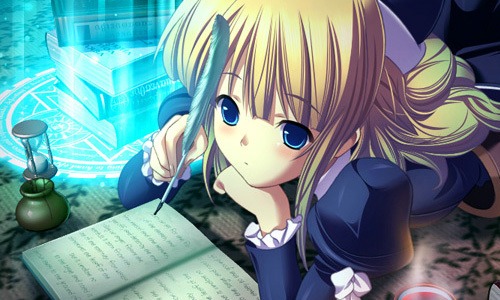
Voice is your unique way of speaking. You use words in ways that make a verbal fingerprint. Verbal ticks like like, um, because, so are as important as how your voice sounds. The trick is writing close to how you speak. Writing has certain rules that need to be followed for clarity. Writing exactly as you speak can be confusing for readers, but grammar has room for your voice once you understand the rules.
You already have a voice, but it may need coaxing and structure. Many bloggers struggle with grammar. Blogging doesn’t require formal grammar like you see in reports, but grammar is still important. The rules should only be broken if doing so improves your message. Breaking grammar without a good reason doesn’t create voice: it creates mud.
The best way of writing as you speak is to imagine you are talking with a friend. Write with that person in mind. Yes, you can also include jokes. It doesn’t matter if they fall as flat as an anime character in orz. If your friend would laugh, some of your readers will too. This avoids writing in a stuffy way. It helps you relax and have fun. Blogging should be fun. What’s the point otherwise? If you enjoy writing about a particular type of anime, it will show. Readers can easily tell when a writer is having a good day or enjoys the subject. Passion and enjoyment allows your words to flow. When you target a general audience, you use general words, and general words are boring. They sag like damp, greasy French fries. When you aim at appealing to everyone, you appeal to no one. And when you don’t enjoy the topic, you fall into stilted words.
When you think about it, publishing online is intimidating. Hundreds of people may read your thoughts. Thousands. Your blog will spill into your offline life. I remember the first time a stranger came up to speak with me about one of my articles. It was surreal and immediately my mind ran through a liturgy of doubts. Was my grammar bad? Did I mess up some research? Did I get something completely wrong? Luckily, the reader liked the article and wanted to offer encouragement. He enjoyed how I write. Once you get comfortable with your voice, people will enjoy your writing more. The genuine you shows through your words. Perhaps better than any other medium, blogs show who the author is over time.
Despite your best efforts, your articles won’t appeal to everyone. If you feel anxious about this idea, you are not alone. Most writers feel this fear at one point. Don’t think about it. Write for that one person. Write for yourself. Write what you like to read. Trolls and hecklers will come out from under their bridges. Don’t allow them to tear you down and ruin the fun you have. Don’t let them change your voice.
Grammar Matters

Alright, it’s time we look at how you can use grammar to frame your voice. Blogging doesn’t require formal grammar, but you need to be as grammatically correct as possible. This helps you get your point across as clear as you can manage. Even the grammar part of writing can be fun. I see you rolling your eyes. Grammar, fun?
Man bacon is the best.
Mmmm. Man bacon. Oh wait. Maybe what I really mean is:
Man, bacon is the best.
Grammar and writing is all about playing with words, and it can be a lot of fun once you learn the rules of the game. Understanding the rules allows you to focus more on the words themselves. Grammar has a dirty little secret, a secret your English teachers don’t want you to know.
Sorry, I can’t tell you yet.
We need to go over the rules of the game first, starting with the sentence. A sentence expresses a complete thought about a single topic. Bloggers get into trouble when they make a sentence work too much. It only confuses the reader. Everything about grammar rotates around the idea of expressing a thought clearly. All the confusing rules about commas, subordinate clauses, appositives, and other arcane jargon focus on details. They are rules about how to clearly link details with the sentence’s purpose. So let’s look at the grammar rules that trip bloggers.
The Cursed Comma
Commas are such small, evil creatures. Look at it sitting in that sentence, staring and laughing. And in that sentence too! Second only to periods, commas are the most used punctuation mark in the English language. My English teachers emptied their red pens correcting my comma mistakes until I learned a simple method for placing commas. Commas represent pauses in speech. To find where a comma should go, read a sentence aloud. If you pause for a breath while reading it, a comma goes there. That’s it. That’s the trick–if you are a fluent speaker anyway. But we still need to understand the basic rules of commas.
Place a comma before a word that connects two sentences. Conjunctions–and, but, or, nor, so, yet– connect two complete and related thoughts together. Both sentences need to have a subject and a verb.
The con sucked. I didn’t have any fun.
The con sucked, and I didn’t have any fun.
Place a comma after if, when, as, because sentence leads.
If you like anime, start a blog.
When you read the sentence aloud, you will want to naturally pause where the comma appears. Contrast this with:
Start a blog if you like anime.
Here, there isn’t an obvious pause. You don’t place a comma before if, when, as, and because when they are at the end of the sentence.
Use commas between items in a list. The Oxford comma has seen some debate in recent years. The Oxford comma is the comma placed just before the and in a list. Some people drop the Oxford, but you can end up with a sentence like this:
I finished watching online videos of my friends, Shin-chan and Moribito.
So I guess my friends are named Shin-chan and Moribito. The Oxford comma improves clarity and saves you from rewriting sentences.
I finished watching online videos of my friends, Shin-chan, and Moribito.
We can rewrite the above sentence for clarity and to avoid the Oxford comma.
I finished watching online videos of Shin-chan, of Moribito and of my friends.
This sentence uses the principle of parallels. Lists are more pleasing when they repeat in a pattern.
Ichigo Kurosaki protected his friends, his family, and strangers.
The sentence works, but the next sentence sounds better:
Ichigo Kurosaki protected his friends, his family, and his neighbors.
If you have lists longer than four items or complex lists that require semicolons, make the list into a bulleted list. Blog readers like these type of lists. Yeah, lists can use semicolons which act as beefed up commas. Take a look:
Bleach’s main characters include Ichigo, who uses Zanketsu; Rukia, who uses Sode no Shirayuki; Orihime, who uses Shun Shun Rikka; Uryu, who uses Heilig Bogen.
Semicolons allow you to stuff more information into a list, but blogging isn’t formal writing. Dump this complex series into a bulleted list.
Bleach’s main characters include:
· Ichigo, who uses Zanketsu.
· Rukia, who uses Sode no Shirayuki.
· Orihime, who uses Shun Shun Rikka.
· Uryu, who uses Heilig Bogen.
Looks much better doesn’t it? Bulleted and numbered lists help readability. Whenever you make a list like this, use a colon after the introducing fragment. You don’t want the list to float without some type of introduction.
Use commas to set off additional information about a word. This additional information can be cut without changing the sentence.
My favorite character, Mugen, fights like a demon.
There are other rules about commas, but these are the most useful to know. I recommend looking at The Elements of Style to learn more. It is a concise book that covers all aspects of grammar.
References
Hale, C., Sin and Syntax: How to Craft Wicked Good Pros,. New York: Three Rivers Press, 2013.
Strunk, W., and E.B. White. The Elements of Style. Longman 4th Edition. 1999.
University of Chicago Press. The Chicago Manual of Style, 16th ed, Chicago: University of Chicago Press, 2010.



